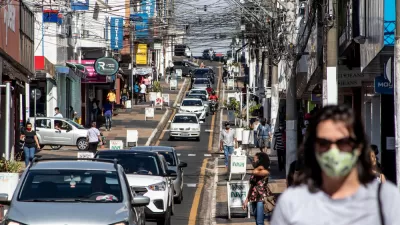The Atlantic Monthly reviews a new book on architect Oscar Niemeyer and his work that- like the infamous city of Brasilia- "continues to enchant and appall students of architecture and urban planning."
It was a heroic and inhuman scheme. From 1956 to 1960, Brazil-in an effort to cleanse itself of its colonial past, to flee its burgeoning social afflictions, and to fulfill its long-prophesied emergence as a great power-conjured a new capital, Brasília, on an empty plateau in an endless savanna 3,500 feet above sea level. The city's planner, the architect Lúcio Costa, found the setting "excessively vast out of scale, like an ocean, with immense clouds moving over it." No invented city could accommodate itself to this wilderness. Instead, Costa declared, Brasília would create its own landscape: he devised a city on a scale as daunting as the setting itself. In conformity not with its environment but with those modernist utopian theories of the rational, sterile "Radiant City," Brasília was not to grow organically but to be born, Costa said, "as if she had been fully grown"-he even refused to visit the site, because he didn't want reality to impinge on the purity of the original design. Brasília was the first place built to be approached by jet, and the city's roads- inspired by Robert Moses's deadening expressways belting New York's outer boroughs- were like runways. Here was a city without a traffic light, containing thoroughfares without crosswalks.
The result was (or should have been) obvious, as Simone de Beauvoir reported after visiting Brasília the year it was inaugurated: "What possible interest could there be in wandering about? The street, that meeting ground of passers-by, of stores and houses, of vehicles and pedestrians ... does not exist in Brasília and never will."
Today, the city is quite correctly regarded as a colossally wrong turn in urban planning-but Brasília, paradoxically, contains some of the most graceful modernist government buildings ever produced. All were designed by Oscar Niemeyer (now 100 years old and still working), who helped select Costa's master plan and who was the creative influence behind the building and shape of the city. Both facts must be considered in any effort to reckon the legacy of Niemeyer-the last great architect of the modernist ascendancy-and his relationship to modernism, a relationship that both spurred and warped his creative achievement."
FULL STORY: A Vision in Concrete

Alabama: Trump Terminates Settlements for Black Communities Harmed By Raw Sewage
Trump deemed the landmark civil rights agreement “illegal DEI and environmental justice policy.”

Study: Maui’s Plan to Convert Vacation Rentals to Long-Term Housing Could Cause Nearly $1 Billion Economic Loss
The plan would reduce visitor accommodation by 25% resulting in 1,900 jobs lost.

Planetizen Federal Action Tracker
A weekly monitor of how Trump’s orders and actions are impacting planners and planning in America.

Waymo Gets Permission to Map SF’s Market Street
If allowed to operate on the traffic-restricted street, Waymo’s autonomous taxis would have a leg up over ride-hailing competitors — and counter the city’s efforts to grow bike and pedestrian on the thoroughfare.

Parklet Symposium Highlights the Success of Shared Spaces
Parklets got a boost during the Covid-19 pandemic, when the concept was translated to outdoor dining programs that offered restaurants a lifeline during the shutdown.

Federal Homelessness Agency Places Entire Staff on Leave
The U.S. Interagency Council on Homelessness is the only federal agency dedicated to preventing and ending homelessness.
Urban Design for Planners 1: Software Tools
This six-course series explores essential urban design concepts using open source software and equips planners with the tools they need to participate fully in the urban design process.
Planning for Universal Design
Learn the tools for implementing Universal Design in planning regulations.
Caltrans
Smith Gee Studio
Institute for Housing and Urban Development Studies (IHS)
City of Grandview
Harvard GSD Executive Education
Toledo-Lucas County Plan Commissions
Salt Lake City
NYU Wagner Graduate School of Public Service



























